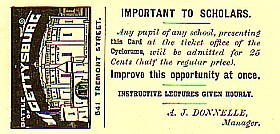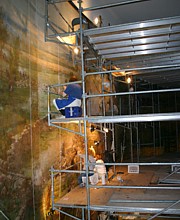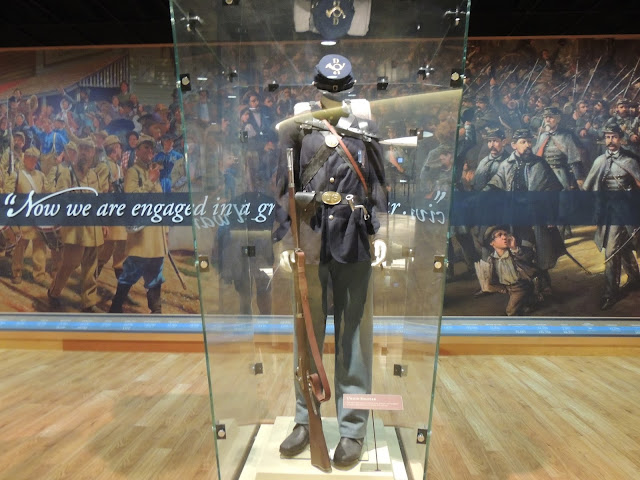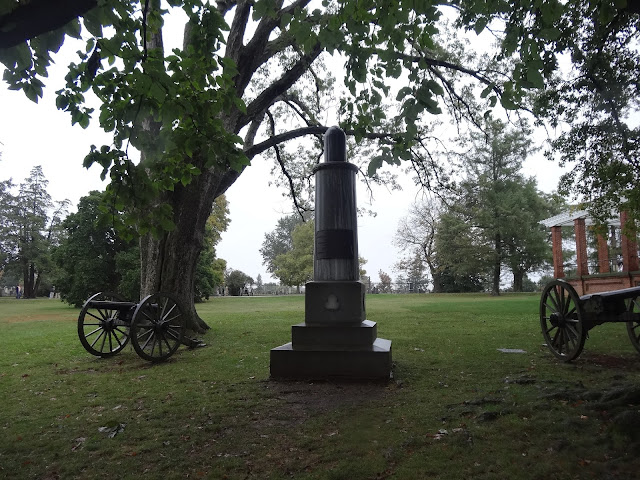Gettysburg, PA
http://www.civilwar.org/battlefields/gettysburg.html
In the summer of 1863, Confederate Gen. Robert E. Lee launched his second invasion of Northern territory. Like his last foray that ended at bloody Antietam, Lee sought to score politically meaningful victories, take the war out of the ravaged Virginia farmland, and gather supplies for his army. He was pursued first by Union Gen. Joseph Hooker, and then by Gen. George Meade, who replaced Hooker in late June. The opposing forces collided at Gettysburg, Pennsylvania, on July 1. In severe fighting, the Confederates swept the Federals from the fields west and north of town, but were unable to secure the heights to the south. The following day, Lee attacked the Federals on the heights, but failed to dislodge the defenders. On July 3rd, Lee attacked the Union center on Cemetery Ridge and was repulsed in what is now known as Pickett’s Charge. Lee's second invasion of the North had failed, and had resulted in heavy casualties; an estimated 51,000 soldiers were killed, wounded, captured, or listed as missing after Gettysburg.
The Cyclorama This painting was surrounding a round center stage, where we stood. The story of the battle was told and the painting would light up the area that was being discussed. There were explosions and screams of the wounded, followed by orders to fire, advance or retreat. It was easy to feel like you were there during the battle, watching from a safe place.
https://www.nps.gov/gett/learn/historyculture/gettysburg-cyclorama.htm
Cycloramas were a very popular form of entertainment in the late 1800's, both in America and Europe. These massive, oil-on-canvas paintings were displayed in special auditoriums and enhanced with landscaped foregrounds sometimes featuring trees, grasses, fences and even life-sized figures. The result was a three-dimensional effect that surrounded viewers who stood on a central platform, literally placing them in the center of the great historic scene. Most cycloramas depicted dramatic events such as great battles, religious epics, or scenes from great works of literature. Hundreds were painted and exhibited in Europe and America during the 1800's, yet most were lost or destroyed as their popularity died out with the introduction of a more entertaining art form, motion pictures.
The "Battle of Gettysburg" Cyclorama at Gettysburg National Military Park is one that has survived. This fantastic painting brings the fury of the final Confederate assault on July 3, 1863 to life, providing the viewer with a sense of what occurred at the battle long touted as the turning point of the Civil War.
The culmination of the battle was captured on canvas by the French artist Paul Philippoteaux, a professional cyclorama painter and artist. Philippoteaux was not present at Gettysburg, but came to the United States in 1879 when he was hired by a group of entrepreneurs to paint this monumental work for a special display in Chicago. Philippoteaux arrived in Gettysburg in 1882 armed with a sketchbook, pencils, pens, and a simple guide book to help him locate the site of the climactic charge. The artist spent several weeks on the battlefield, observing details of the terrain and making hundreds of sketches. To help him recall the landscape with accuracy, Philippoteaux hired a Gettysburg photographer to produce a series of panoramic photographs for his use. These images are some of the earliest detailed photographs of Cemetery Ridge, the Angle and the "High Water Mark", and the field of Pickett's Charge. Philippoteaux was also lucky enough to interview a number of veterans of the battle, who helped with suggestions on how to depict the chaos of battle.
Armed with a vast amount of information and ideas, Philippoteaux returned to his studio where he immediately set about laying out the great work. A team of assistants helped him sketch out every detail including soldiers, trees, crops, fences and stone walls, and then began applying tons of oil paint. The phenomenal work took over a year and one-half to complete. The "Cyclorama of the Battle of Gettysburg" opened to the public in Chicago in 1883, complete with a three-dimensional earthen foreground littered with the relics of battle, stone walls, shattered trees and broken fences. Visitors were awed by the painting's spectacular realism. Veterans of the battle, including General John Gibbon whose troops repulsed Pickett's Division on July 3, wrote of its splendor and realism.

(National Park Service)
Hearing that the Boston cyclorama was up for sale, a Gettysburg-area entrepreneur purchased the painting and moved it with its props and accoutrements of the foreground, to Gettysburg. The painting arrived in good condition, though several of the panels were ripped and torn and some had rotted around the bottom due to moisture in the soil of the foreground. Repairs were made to the rips by taking portions of the skyline, the upper portion of which was evidently discarded, and stitching them into place where they were painted over by artists as each panel was hung. The cyclorama opened for public exhibition just in time for the 1913 Anniversary celebration of the Battle of Gettysburg, in a specially constructed building on Baltimore Street, and remained there for approximately forty years.
Purchased by the National Park Service in the late 1940's, the painting was moved to the newly constructed park visitor center in 1962. The artistic work underwent a massive restoration project that required hours of hand labor to repair water damaged portions of the painting and two large sections faded by years of direct sunlight. The project was completed and the cyclorama re-opened for public viewing in 1962 with the dedication of the National Park Service Visitor Center, which was later titled as the Cyclorama Center. The Gettysburg Cyclorama is 377 feet long, 42 feet high and weighs 12.5 tons.

(Olin Associates-National Park Service)
Initiated in 2003, the Gettysburg Cyclorama underwent a thirteen million dollar rehabilitation project. Conservation specialists from Olin Associates repaired unstable sections of the canvas and restored original details lost during the numerous repair and preservation attempts on the painting. The cyclorama was moved to the new Gettysburg National Military Park Museum and Visitor Center and placed in its own unique viewing auditorium with a restored skyline and foreground. The conserved painting and restored foreground was unveiled to visitors on September 26, 2008 during the grand opening of the visitor center.
The fate of the other Gettysburg Cycloramas has been less fortunate. The Chicago painting was eventually sold and was in private ownership until its donation to Wake Forest University in Winston-Salem, North Carolina. The painting has survived, though it is in desperate need of restoration and a permanent home. Two more versions of the Gettysburg Cyclorama were painted and exhibited, including one shown in Denver, Colorado. One of these was cut up for use as tents by native Americans on a Shoshone Indian Reservation after the turn of the century. The fate of the other painting is unknown.

This photo shows how the circular painting surrounds the center stage
The Museum
Firearms from the civil war
Uniforms
Sorry, the photo is blurred. this is what it says.
The Civil War and Gettysburg
The four years of the Civil War were the bloodiest in the nation's history. Some 620,000 soldiers and sailors died in the war ---- a little less than 2 percent of the population. A loss on the same scale today would equal 6 million deaths.
Americans fought one another over three fundamental issues, the survival of the Union, the fate of slavery, and the common rights of citizenship ---- what it means to be an American. The war resolved the first two issues. The nation struggles with the third to this day.
Roughly 11,000 men died at the Battle of Gettysburg alone and another 40,000 were wounded, captured, or missing. These 51,000 casualties equaled about 20 times the population of the small Pennsylvania town.
Artifacts from the war.
Lincoln's election enraged the southern slave owners.
The first state to secede.
United States Flag 1861
Recruitment posters
Encampment
Cavalryman
Cannon
Quotations of interest.
Dwight David Eisenhower's connection to Gettysburg
Photos of the cemetery, and it's monuments.
The U.S Military cemetery
The Gettysburg Address
Neither one of us can remember what this is a picture of, but I'm leaving it in to show the rain that day.


































































No comments:
Post a Comment